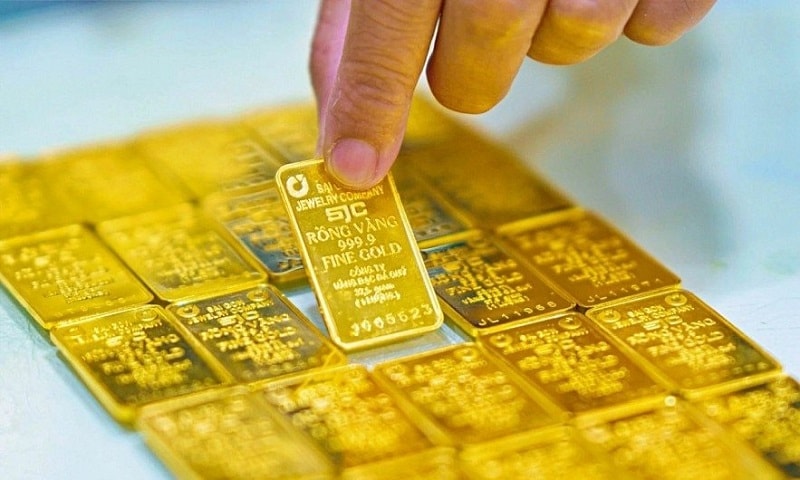How high will gold prices rise?
Gold prices in the international market are expected to continue fluctuating, with persistent record-breaking milestones, especially in the case of gold rings.

Business Forum magazine recently conducted an interview with Mr. Phan Dũng Khánh, a gold expert, regarding gold price fluctuations.
- What is your perspective on the current trends in gold prices?
In 2024, there are two main forecasts from international financial institutions and investment organizations regarding future gold prices, ranging from $3,500 to $5,000 per ounce.
According to the first group, by the middle of 2025, global gold prices would have surpassed the $3,000–3,500 per ounce mark. According to the second group, gold prices may go even further, hitting $3,500 to $5,000 an ounce. It is clear that the price of gold has surpassed $3,000 per ounce earlier than anticipated, even though the $3,500 per ounce milestone has not yet been reached.
This trend is influenced by several key factors:
- The ongoing conflicts in Gaza and the Russia-Ukraine war, which remain unresolved.
- Large gold-buying activities by major countries and investment funds (such as China and the SPDR Gold ETF).
- A weakening U.S. dollar, with the DXY index dropping from 110 to 103, supports higher gold prices.
Given these factors, I believe that while gold may not reach $3,500 per ounce in the short term, it is on track to hit $3,200 per ounce in the first half of this year.
The rising international gold price has also pushed domestic gold prices to new highs, especially gold rings, which hit a historic milestone of 100 million VND per tael on March 19. The reason why gold rings have increased in price faster than SJC gold bars is due to stricter supply and demand control for SJC gold bars. As a result, while rising domestic gold prices are understandable, they still follow market principles—meaning that the faster gold rings rise, the sharper their decline will be if a reversal occurs.
- Conversely, what factors might prevent gold from reaching the $3,500 per ounce threshold as expected?
While conflicts in Gaza and the Russia-Ukraine war remain unresolved, there are signs of progress—what some might call "light at the end of the tunnel." It’s only a matter of time before these conflicts reach a resolution.
Despite increased gold purchases by nations and institutions, actual demand remains relatively low. Many large institutions already acquired gold at lower prices, so they are now buying more cautiously. They may even pause buying at excessively high prices or begin selling off some holdings.
Although the U.S. dollar has weakened, former President Donald Trump has emphasized strengthening the US dollar. Retaliatory tariff policies and escalating trade wars could push inflation higher, leading to a stronger dollar. The Federal Reserve (FED) is being cautious with rate cuts—initially planning four cuts this year but now reducing expectations to two. The U.S. Treasury and President have acknowledged recession risks, which could force the FED to raise interest rates instead of cutting them.
Given this scenario, if gold prices do not reach their peak due to macroeconomic movements in the coming weeks or the first half of 2025, the downward pressure on gold prices will intensify by the end of 2025.
- Do gold market fluctuations affect Vietnam’s exchange rate, monetary policy, or foreign exchange policies?
The impact of gold market fluctuations—both domestically and internationally—on Vietnam’s exchange rate and foreign exchange policies is minimal.
A clear example is that despite gold consistently hitting new highs last year, Vietnam’s exchange rate remained within a controlled fluctuation range. Similarly, even in recent days, as gold prices reached historic records, the exchange rate has remained stable or even declined within a lower trading range.
Another illustration is how the stock market in Vietnam rose while the U.S. stock market fell when President Donald Trump's tariff measures were put into effect. Despite net selling by foreign investors, local capital has absorbed the withdrawals, and the VN-Index is still over 1,300 points.
With GDP growth predicted to reach double digits in the next years and 8% in 2025, investor confidence in Vietnam's economy is still high. Given that economic confidence is reflected in the stock market, it is clear that changes in the price of gold are unlikely to have a major effect on Vietnam's economic policies under the existing management framework.
- Many investors remain interested in gold’s profitability. What advice do you have for investment strategies in this context?
For gold investments, investors who have already bought gold at lower prices can continue to accumulate. New investors can also buy, but should limit their allocation and avoid borrowing or using leverage.
For overall investment strategies, I suggest:
- Allocate 5–10%, or up to 20%, of idle capital to asset preservation channels like gold and savings.
- Stock market investments remain attractive—although prices have recently risen, the market endured two years of sluggish performance, leaving room for further gains.
- Real estate is also an option, as the sector is showing signs of recovery.
Finally, investors should minimize borrowing and avoid going all-in on a single investment channel. While it is acceptable to focus on one asset class more than others, diversification remains key to mitigating risks.
Thank you for your insights!








